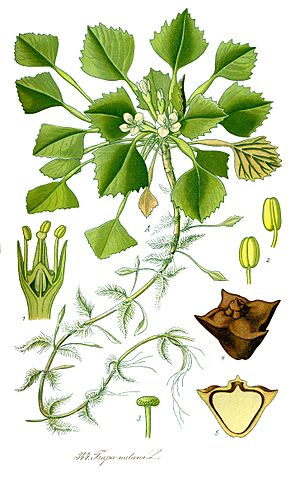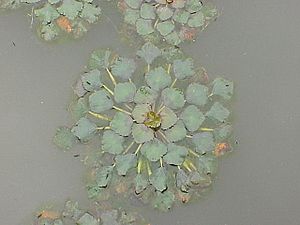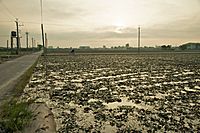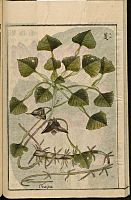Water caltrop facts for kids
Quick facts for kids Water caltrop |
|
|---|---|
 |
|
| Trapa natans | |
| Scientific classification |
|
| Kingdom: | Plantae |
| Clade: | Tracheophytes |
| Clade: | Angiosperms |
| Clade: | Eudicots |
| Clade: | Rosids |
| Order: | Myrtales |
| Family: | Lythraceae |
| Subfamily: | Trapoideae Voigt |
| Genus: | Trapa L. |
| Type species | |
| Trapa natans L.
|
|
| Species | |
|
|
The water caltrop is a cool aquatic plant! It's actually the name for three different types of plants in the Trapa family: Trapa natans, Trapa bicornis, and the rare Trapa rossica. People also call it by many other names, like buffalo nut, bat nut, devil pod, or singhara. Sometimes, it's even called a water chestnut, but that can be confusing because there's another plant with that name!
These plants float on water and grow every year. They like slow-moving fresh water that's up to 5 meters (about 16 feet) deep. You can find them naturally in warm parts of Europe, Asia, and Africa. Water caltrops grow interesting-shaped fruits. For example, the T. bicornis fruit looks a bit like a bull's head or a flying bat! Inside each fruit is a big, starchy seed. People in China and India have been growing and eating the seeds of T. natans and T. bicornis for at least 3,000 years.
Contents
What Does a Water Caltrop Look Like?
The stem of the water caltrop grows underwater, reaching about 3.7 to 4.6 meters (12 to 15 feet) long. It's held in the mud by tiny roots. This plant has two kinds of leaves. Some leaves are feathery and stay underwater along the stem. Other leaves float on the water's surface, forming a circle called a rosette.
These floating leaves have jagged edges and are shaped like an oval or triangle, about 2 to 3 centimeters (1 inch) long. Their stems are puffy, about 5 to 9 centimeters (2 to 3.5 inches) long, which helps the leaves float better. In early summer, the plant grows white flowers with four petals. Insects help these flowers make seeds. The fruit is a nut with four sharp, barbed spines, each about 1.3 centimeters (0.5 inches) long. The seeds can stay alive for up to 12 years, but most sprout within the first two years.
The plant spreads when its rosettes and fruits break off and float to new areas. They can also stick to animals or objects and be carried to new places.
It's important not to confuse the water caltrop with the Eleocharis dulcis. Even though they share a similar name, Eleocharis dulcis is a different plant. It's a type of sedge grown for its round, crunchy underground stems (called corms), which are often used in Chinese food.
Special Chemicals in Water Caltrop
Scientists have found a special chemical called Bicornin in T. bicornis. It's a type of ellagitannin.
Water Caltrop Through Time
How Water Caltrops Evolved
The Trapa plant family has a long history! We've found many old fossil seeds of water caltrops. These fossils date back to the Cenozoic Era, starting from the Eocene period. They've been found across Europe, China, and North America. However, water caltrops died out in North America before the Pleistocene Ice Age. The oldest known fossils of Trapa leaves were found in Cretaceous Alaska.
Where the Name Comes From
The name Trapa comes from a Latin word, calcitrappa, which means "thistle". This is also where the common name "caltrop" comes from.
In Japanese, the plant is called hishi. This word also means a "diamond or rhombus shape." The famous company Mitsubishi actually got its name and logo from the water caltrop!
In India, it's called Shringataka in Sanskrit, which became Shingara in Hindi. In Eastern India, a fried pastry called samosa is also called Shingara because its shape looks like the water caltrop fruit.
History and Uses
Long ago, people in southern Germany might have eaten a lot of wild water caltrops. It was a big part of their diet, especially if their farm crops failed. But today, water caltrop is very rare in Germany and is considered an endangered species.
Water caltrops have been important in China for a very long time. During the Chinese Zhou Dynasty, people used them as offerings in prayers. An old Chinese book from 1694, the Chinese Herbal Medicine Summary, even said that water caltrop could help with fever and drunkenness.
In India and Pakistan, water caltrop is known as singhara or paniphal. It's grown a lot in freshwater lakes there. People eat the fruits raw or boiled. When the fruit is dried, it's ground into a flour called singhare ka atta. This flour is used in many religious ceremonies. It can also be eaten during Hindu fasting days, like the navratas, as part of a "fruit diet."
You could buy water caltrops in markets all over Europe until about 1880. In northern Italy, people sold the nuts roasted, just like sweet chestnuts are sold today. Water caltrops were a common food in many parts of Europe until the early 1900s. But now, they are rare there. This happened for several reasons, like changes in climate, changes in water quality, and the draining of many wetlands and ponds.
T. natans was brought to the US state of Massachusetts around 1874. A gardener at Harvard University Botanic Garden threw some seeds into local ponds. Soon, the plant started to grow very quickly. By 1879, some botanists worried it would become a problem because it grew so thick. One botanist, George E. Davenport, who helped spread the seeds, didn't think it would be a "nuisance." He thought such a nice plant with tasty nuts would be popular with kids, like hickory nuts.
However, the water caltrop has become an invasive species in many parts of the United States, from Vermont to Virginia. It's even called a "noxious weed" in Florida, North Carolina, and Washington. As of 2020, both T. natans and T. bicornis are growing wild in US waterways. In Australia and New South Wales, water caltrop is also considered a noxious weed.
-
Water caltrop field in Tainan City
Rules About Selling Water Caltrop in the United States
In 1956, it became against the law to sell or ship T. natans in the United States. If you did, you could face a fine or even jail time. But this law was changed on December 27, 2020, so it's no longer banned for sale or shipment.
Water Caltrop and Health
Water caltrops can sometimes play a role in spreading a health issue called Fasciolopsiasis. This happens because tiny parasites, called flukes, can attach to the surfaces of water plants, including water caltrop leaves and fruits. If people or animals eat these infected plants raw or not cooked enough, the flukes can cause problems. This issue is more common in places like China, Southeast Asia, and India.
How People Use Water Caltrop
The fruits of the water caltrop are edible! You can eat them raw or cooked. The seeds inside are also good to eat. In many parts of Asia, people enjoy eating water caltrops during the Mid-Autumn Festival.
Lua error in Module:Interwiki_extra at line 84: attempt to index field 'wikibase' (a nil value).
See also
 In Spanish: Trapa para niños
In Spanish: Trapa para niños






